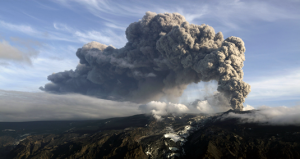
Volcanic ash can damage jet engines, and Ludwig-Maximilians-Universitaet (LMU) in Munich volcanologists have developed a new empirical model for assessment of the risk. Their results show that tests using sand do not reflect the behavior of ash in this context.
Volcanic ash is hazardous to commercial aircraft because, when drawn into jet engines, it can severely damage the turbines as well as compromising the operation of other components. For this reason, the eruption of the volcano Eyjafjallajökull in Iceland in 2010 led to widespread disruption of air traffic over Europe and resulted in considerable economic losses. “Damage to the engines is primarily attributable to the deposition of melted ash on the vanes of the turbines,” says Professor Donald Dingwell, Director of the Department of Earth and Environmental Sciences at LMU. “And one of the grounds for the extensive closure of airspace in 2010 was that nothing was known about the melting behavior of volcanic ash under the conditions found inside jet engines.
” He and his research group have now investigated the issue, and shown that the chemical composition of the ash, which varies depending on its source, plays a crucial role in determining how much damage it can cause. Furthermore, the new study shows that the standard tests, which use sand or dust particles as proxies, do not reproduce the effects of volcanic ash on jet engines. On the basis of these results, the LMU team has developed a model which enables them to provide more realistic estimates of the risk to aviation posed by volcanic ash. Their findings appear online in the journal Nature Communications.
Temperatures in working jet engines range between 1200°C and 2000°C. Under such conditions, volcanic ash particles melt and the molten material is deposited on the hot surfaces of the turbines. This in turn can lead to clogging of fuel nozzles, cooling ducts and other engine parts. In addition, ash particles may penetrate the protective ceramic coatings on the turbines, compromising their performance as thermal barriers and exacerbating damage. “The only available data concerning the effects of airborne particles on turbines come from outdated tests based on the use of sand,” Dingwell points out. “However, in terms of its chemical composition, volcanic ash differs significantly from sand. Furthermore, ash varies widely in composition depending on which volcano it comes from.
Ash melts at lower temperatures than sand
The LMU researchers have therefore performed the first systematic analysis of the melting behavior of volcanic ash obtained from a variety of sources. They heated samples of ash from nine different volcanos at various rates up to a maximum temperature of 1650°C, thus simulating the range of temperatures found at different locations within commercial jet engines. Melting temperatures were found to depend strongly on the chemical composition of the ash: The higher the fraction of basic oxides in the sample, the lower the melting temperature. “With the aid of our data, we were able to develop an empirical model, which describes how the melting behavior of volcanic ash as a function of its chemical composition and the rate at which it is heated,” Dingwell explains. “We also confirmed earlier reports that ash generally melts at significantly lower temperatures than dust particles or sand—and consequently will be deposited at much higher rates on hot engine parts.” He and his colleagues are therefore convinced that tests based on the use of sand are unsuitable for assessing the effects of volcanic ash on turbines, because they severely underestimate the degree of damage that the latter particulates can cause.
“With this model, we provide the basis for more accurate estimation of the effects of the deposition of volcanic ash in turbine engines,” says Dingwell. The researchers now plan to broaden their database in order to extend the applicability of the model. They also intend to explore how jet engines can be rendered less susceptible to damage by volcanic ash – by developing deposition-resistant coatings for component surfaces.
Reference:
Wenjia Song et al. Volcanic ash melting under conditions relevant to ash turbine interactions, Nature Communications (2016). DOI: 10.1038/ncomms10795
Note: The above post is reprinted from materials provided by Ludwig Maximilian University of Munich.









